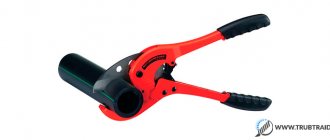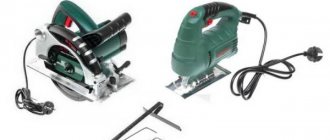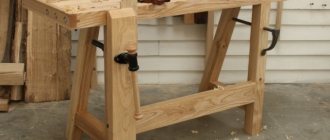To work with wooden, plastic and even metal workpieces at home, a circular hand saw is often used as a more productive analogue of the simplest sawing tool. It has several varieties and application nuances that are important to consider when working.
Circular hand saw device
When constructing and repairing both your own home and on a professional basis, a circular hand saw becomes a convenient aid in your work. The tool is very convenient for sawing wood of different thicknesses, thin metal and plastic products, such as baseboards. There are several varieties of this manual circular saw, but the design of each of them is typical. The standard design consists of:
- Protective plastic housing with one or two handles.
- A special casing for the saw blade that performs protective functions during operation.
- Platforms for holding and guiding the disc. It is necessary to adjust the depth and angle of the cut.
- Riving knife. It is needed to free the knife if it gets stuck in the wood.
- Electric motor. A special disk is attached to its shaft using bolts.
Types of circular saws
A stationary circular saw is installed on a stationary workbench or table. It has high productivity due to its powerful engine and large saw blade. In addition, the presence of a stationary working surface allows for convenient and accurate cutting of long pieces of wood.
Circular machine
A hand-held circular saw is usually used in everyday life. Its main advantages are small dimensions, weight and mobility. It allows you to cut small wooden boards and bars, as well as wood products. You don't need a workbench to use it. Almost all models are equipped with an adjustable sole, which makes their use more comfortable.
Hand circular saw
Compact size and weight allow the table saw to combine the positive qualities of the types described above. They are distinguished by mobility and the ability to finely adjust the cutting angle. The disadvantage of such a tool is the small radius of the saw blade and the low power of the electric motor.
Table saw - machine
The plunge-cut circular saw is a modernized hand-held circular saw. Design features allow for more precise cuts at different angles relative to the horizontal plane, as well as for making local cuts. The main disadvantage of the tool is its high cost.
Plunge circular saw
Application area
A circular saw is mainly used for working with wood products. With its help you can perform the following types of work:
- Longitudinal and transverse cutting of workpieces;
- performing local cuts;
- trimming ends;
- firewood preparation;
- production of boards, bars and other wood products.
In addition, when installing a specialized cutting element, they can be used to cut plastic, artificial stone and tiles.
We also recommend reading a useful article about techniques for even cutting with a circular saw with and without attachments. The article discusses the most necessary techniques and techniques for cutting various materials, from unedged boards to timber and logs.
Working principle of a circular hand saw
The tool is used for even sawing of surfaces, longitudinally or transversely. Arc cutting is not possible with a circular hand saw. The principle of operation of such a unit is simple:
- Torque is transmitted from the electric motor shaft to the cutting disc.
- The sawing disk rotates around its axis at high speed, making it easy to cut the desired surface.
Depending on the cutting depth, the tool is divided into several categories:
- Mini circular hand saws are capable of cutting material up to 46 mm thick.
- The average tool can handle surfaces up to 55 mm.
- Large equipment can cut workpieces with a thickness of about 70 mm.
- Professional equipment cuts products about 140 mm thick.
Types of Circular Hand Saw
There is a large selection of circular saws on the shelves of construction stores. All variety can be divided into:
- A hand tool that the master moves independently.
- A stationary saw on a special table, designed for placement in work shops and workshops.
The circular hand saw is divided according to power classes into:
- Household appliances with power up to 2.2 kW.
- Semi-professional models that are more powerful than household ones. They have great functionality.
- Professional units with increased power and functionality. Used in production.
Another difference is the method of transmitting torque, so they distinguish:
- Electric models connected to a standard power supply.
- A cordless hand-held circular saw is convenient where you don't need a nearby power outlet.
- Models with manual drive, which are currently practically not used, are becoming a thing of the past.
How to choose a circular hand saw?
When purchasing a tool, you should focus on a number of specific parameters:
- Engine power. The higher it is, the faster and with less effort you can cut. In addition, large-diameter cutting discs can be installed on powerful saws (from 3 kW).
- Cutting depth. There are 4 standard sizes that you need to select based on your needs.
- A hand-held circular saw for wood can have an adjustable cutting angle.
- Stationary chip removal system or the ability to connect a vacuum cleaner. A very convenient option that allows you to work practically without dust and debris in the workshop or at home.
- The start lock is an important safety feature that prevents the tool from being started accidentally.
Functions of a circular hand saw
The main “duty” of a circular saw is to cut large quantities of boards, drywall, laminate, plastic panels, soft metal and more. It is indispensable when building a house or cottage, and is also useful when laying floors in an apartment or covering walls with decorative panels. For speed of work and ease of use, the circular electric hand saw is equipped with a number of additional functions:
- Immersion in the material. This function is very convenient when working with large slabs.
- Adjusting the speed of rotation of the cutting disc. To work with different materials, different rotation speeds are required to obtain an even cut without burrs.
- The soft start function is necessary to increase the service life of the cutting blade. Thanks to it, the saw smoothly picks up speed after starting, rather than immediately spinning the shaft to maximum speed.
- A laser pointer is an optional accessory for a handheld circular saw. However, such a pointer is convenient to use when carrying out quick work.
Circular saw blades
An important consumable in a cutting tool is the cutting disc. Each model has its own characteristics:
- height and number of teeth;
- cutting profile geometry.
Conventionally, all disks for hand-held circular saws are divided into:
- Consumables for soft materials such as wood or plastic. They have a positive sharpening angle, the number of teeth is about 50-100, which ensures an even cut.
- Discs for hard materials are produced with a negative sharpening angle and fewer teeth. They can cut through harder materials, but the edges will be more jagged.
Tool selection criteria
In a market where there are many hand-held circular saws, a comparison of the main indicators will help with your choice. When choosing a device, pay attention to the characteristics:
- Electric motor power. The greater the power, the greater the number of cuts that can be made per unit of time. The larger the disk that you plan to attach to the shaft, the more powerful the tool is needed. Increasing power allows you to work with harder wood species. But the more powerful the device, the heavier it is. A model with a 1200 W motor weighs about four kilograms, and if the motor has a power of 2000 W, then the saw’s weight will already be seven kilograms.
The material from which the body is made. It must be durable and be able to withstand the vibration that occurs during operation. Models can be metal or plastic. The weight of the device also depends on the material of the case.- Minimum and maximum cutting depth. This indicator depends on the engine power. In total, there are four ranges of cut sizes. It is worth paying attention to the presence of a cutting depth regulator.
- Disc rotation speed. The accuracy of cutting a part directly depends on the rotation speed. The higher the speed, the more accurate the cut. You need to know that the rotation speed does not directly depend on the motor power. There are low-power saws that have a high blade rotation speed, and these tools cut fragile material very carefully.
- Tilt angle adjustment. Most often, this function is used when performing professional work. It is not needed for amateur cuts.
- Handle design. Its ergonomics influence productivity, convenience and comfort in work. Before purchasing, it is imperative that the instrument be checked “in hand”. If there are doubts, then another model should be considered.
- Type of equipment. Today, manufacturers offer corded and corded tools. Each type has its own advantages and disadvantages. Cordless saws are heavier, but autonomous. Suitable for any unexpected situation. Corded tools are lighter in weight, but require a constant supply of electrical power.
- Replacing disks. You need to pay attention to how the disk is changed. There are simple replacement methods, and there are models that require the simultaneous participation of two keys.
- The type of blades that are suitable for a specific saw model.
- The presence or absence of built-in electronics.
Rating of circular hand saws
Professional builders and home craftsmen identify certain tool models that have the most optimal characteristics for the job. Among them:
- Makita HS7601
is an excellent device for home use with two branded disks included. Cost – $121. - DeWALT DWE560
is a model with the ability to connect a construction vacuum cleaner. Cost – $140. - Hammer CRP 1500 D
is a high-quality lightweight saw with a convenient carrying case. Cost – $93. - Bosch GKS 190
. The Bosch hand-held circular saw is considered one of the best tools in its price segment. Cost – $128.
Hand circular saw table
When working with a large volume of sawn material, it is not always comfortable to hold the tool in your hands for a long time. It is much more convenient to secure the tool on a special table, so the cut will be more accurate and faster. All masters prefer to use:
- Factory tables purchased from a store. They can be either stationary or portable.
- Homemade tables, the advantage of which are individual sizes suitable for the workshop area and additional options.
After making your own table, it is important to know how to properly secure your handheld circular saw to your table. There are just a few rules here:
- The instrument is placed inside a prepared compartment that is exactly the right size for the instrument.
- The saw base is securely attached to the table with bolts.
- The disk should fit freely into the slot.
What is it and what can she do?
A circular saw is a specialized tool primarily intended for cutting wood and wood products. Structurally, it can be divided into the following types:
- Stationary;
- Manual;
- Tabletop;
- Submersible.
In all cases, a metal disk with teeth located around the circumference is used as a cutting element.
With a circular saw you can make cuts in wood up to 60-70 mm deep; some craftsmen even manage to evenly cut a 100x100 beam or a 150x150 log with a circular saw using special devices.
The tool can also cut plywood, chipboard, chipboard, MDF and even soft metals. The main thing is to select the right disk for each task, use the correct cutting techniques and devices.
How to use a circular hand saw?
There are standard instructions on how to use a hand-held circular saw, which for different models will differ only in nuances:
- Before starting work, it is important to ensure that the tool is in working order.
- Secure the cutting blade, adjust the position of the guide pin, check the protective cover and the parallelism of the stop with the groove and the pin.
- Set the minimum required cutting depth.
- Set the guide to the size of the material and mark it.
- Make a test cut 3-5 mm long.
- Continue working without stopping along the entire movement of the disk.
- You can use adhesive tape at the cut site to prevent chipping.
Work rules and safety precautions
The circular saw is a dangerous tool and requires careful handling and compliance with safety regulations. To prevent injuries and cuts, you must follow a number of simple rules:
- Before sawing wood, you need to make sure that there are no metal nails or screws in the workpiece.
- Inspection and repair of the tool is carried out only when it is completely disconnected from the network.
- It is not allowed to clean the saw from dust by hand. Only with a special brush.
- It is advisable to wear safety glasses when working.
- You need to work slowly, carefully and carefully.
- If you need to support the workpiece, the fingers of the hand holding the part should be parallel to the cutting line.
A circular saw is a very serious tool. You have to work on it responsibly, carefully and accurately.











